Kizashi puts Suzuki into the vanishing midsize flow
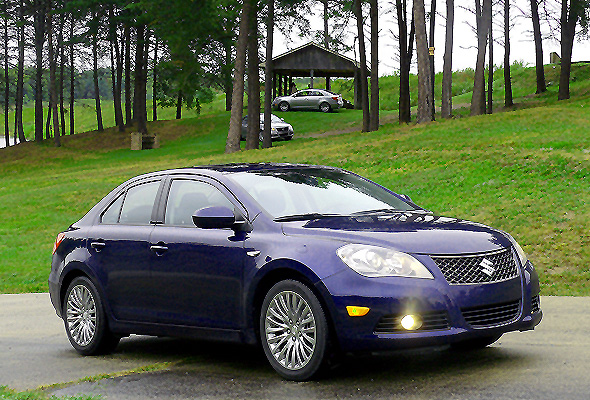 RALEIGH, N.C. — The efficient combination of design, quality, engineering, efficiency, and economy of purchase and operation has thrust Japanese cars to the level of world standard. But it also stirs up a couple of intriguing questions. First question: If Toyota is the largest-selling car marque back in Japan, what brand is second in sales in the homeland? The second question is: Why is Japanese engineer Hidetoshi Kumashiro wearing a ball cap with “Minnesota” emblazoned in script on the front?
RALEIGH, N.C. — The efficient combination of design, quality, engineering, efficiency, and economy of purchase and operation has thrust Japanese cars to the level of world standard. But it also stirs up a couple of intriguing questions. First question: If Toyota is the largest-selling car marque back in Japan, what brand is second in sales in the homeland? The second question is: Why is Japanese engineer Hidetoshi Kumashiro wearing a ball cap with “Minnesota” emblazoned in script on the front?
For the first question, which would you rank second to Toyota in car sales in Japan: Nissan, Honda, Suzuki, Mazda, or Subaru? If you guessed Honda, you might be judging by U.S. sales, where Honda challenges Toyota. If you said Nissan — as I would have — you would be close, because a decade ago, Nissan was second. Nope, the correct answer is Suzuki.
Suzuki makes numerous subcompact and compact cars in Japan, and they sell well because the company’s uncompromising engineering and enthusiastic leanings makes the cars fun to drive, something U.S. consumers and race fans might know best from Suzuki’s motorcycles. It is time, perhaps, for Suzuki to come of age in the U.S., and the perfect vehicle to take the company to its objective in this country is an all-new car called the Kizashi.
The Kizashi, once test-driven, will be as surprising to U.S. consumers as the news that Suzuki is No. 2 only to Toyota in Japan. The new car lives up to its name, which, loosely translated, means something very good is coming. The Kizashi is very good indeed, regardless of what type of car you’re interested in. It is not a soft, squishy little commuter car, but a bold and aggressive sports sedan that will bring a smile to the face of driving enthusiasts, and will astound drivers of more boring sedans who never will be subtly coaxed into learning how much fun everyday driving can be.
As for the second question, about why Hide Kumashiro is wearing a Minnesota cap, I asked him where it came from. “The airport,” he said, grinning broadly. Kumashiro is the chief engineer on the Kizashi, and as if to validate the new car’s stature as a thoroughbred, the company did its cold-weather testing in Minnesota. Great choice. Just as impressive as the fact Suzuki went to Death Valley, Calif., for hot-weather tests. Maybe Suzuki would have listed all-wheel drive as an option anyway, but after testing in Minnesota winters, there was no question about it, and AWD is a mere $1,250 option on all models with the automatic CVT (continuously variable transmission). Otherwise, the Kizashi is powered by its 2.4-liter 4-cylinder turning the front wheels.
Suzuki has never made a midsize car before, and it knows how ferocious the competition is in that segment. Maybe it was fortunate timing, but Suzuki comes in just as nearly all its midsize rivals seem to be abandoning the segment. Every company has tried to make its midsize cars more fun to drive, but the only ones to have mastered it seem to be BMW, Audi, and maybe Mercedes and certain models of Volkswagen. Gene Brown, Suzuki’s vice president of marketing, said, “Normally, you have to spend some serious money to get a sporty car in that segment. But the dynamic excitement of a German car, the Kizashi has premium handling, premium performance, and premium craftsmanship, without the premium price. We like to say it is a ‘Premium car without the premium.’ ”
I think such mainstream midsize cars as the Honda Accord, Toyota Camry, Nissan Altima and Mazda6, all are very good vehicles, brimming with technical excellence and all the newest features, and with enormous amounts of room. It is a measure of achievement that the Ford Fusion and Chevrolet Malibu have improved enough to compete with them. But as they all swam upstream from midsize mainstream, I’ve come to appreciate their predecessors more than ever. In the process of growing larger in the last couple of years, to nearly full-size roominess. they left behind the better agility of lighter, leaner vehicles, pretty well abandoning the pursuit of sportiness.
All the better for the Suzuki Kizashi, which fits right in there where those “former” midsize cars were, and will allow all its drivers to be more enthusiastic in a strong, solidly-built 4-door sedan closer to perfect size.
The Kizashi also slides in under those rivals that have gone up over $30,000 in many cases. The Kizashi will start under $20,000 in base form, with a high-strength steel skeleton under its sheet metal, and a potent 2.4-liter 4-cylinder engine under its hood. Next up is the SE, with standard continuously-variable automatic transmission and larger 17-inch wheels, for $21,500. Suzuki officials project the SE as the top seller. A sportier GTS with 18-inch wheels is also available. At the top of the line is the SLS, with leather seats and trim, 3-stage heated seats, rear parking assist, and other upgrades, all packaged in for $25,500 — well under the loaded versions of all its competitors.
The Kizashi was introduced first to the automotive media at a test-drive session that started in Raleigh-Durham, and continued as we drove to Virginia International Raceway, and then back. While at VIR, we took the Kizashis out on the road-racing course and ran them through some comparison tests for handling and emergency maneuvers against such cars as the Accord, Camry, Altima, Subaru, and even an Acura TSX, Volkswagen Passat, and an Audi A4.
In every case, the Kizashi handled itself with smooth precision. Or, rather, we handled the Kizashi and were universally impressed with how precise its steering and handling was, and how well it outperformed the other cars. Granted, those weren’t the highest-performance models of the competitors, but the point is, even the base Kizashi is built for high-performance handling, without ever compromising its comfort. Swerving through a slalom of cones, cutting sharply in a sustained-speed lane-change, and going through altered cone-lined sections of the race track all made the Kizashi stand out.
{IMG2}
When we were finished, they cleared the cones off the racetrack and we went out on the track and drove some hot laps as though we were out of our helmeted heads. At 3,250 pounds, the Kizashi’s KYB shocks and multilink rear suspension coupled with the car’s very firm torsional rigidity from use of high-tensile-strength steel, made it stay flat and easily controlled in every race track corner, just as it had in the slaloms and lane-change exercises.
In the U.S., Suzuki motorcycles stand out from road cruiser to off-road, motocross and road-racing jewels of mechanical excellence. Suzuki also builds exemplary outboard motors. Most U.S. consumers barely knew Suzuki even made cars, and if it hadn’t been for its alliance with General Motors, for whom it produced the Geo Metro and the Tracker, almost nobody would know it.
Never mind that Suzuki made and sold its subcompact Sprint in the U.S., even while the Metro was selling at the Chevy dealer down the block. While Suzuki made its 3-cylinder Metro as the best high-mileage car ever sold by GM, the Sprint had a 4-cylinder, high-performance model that car was a blast to drive, and still got fantastic fuel economy.
The only exceptions to Suzuki’s enthusiast heritage might be the rebranded — and fortunately short-lived — Korean-built Daewoos that General Motors allowed Suzuki to sell as the Verona and Forenza for a few years. My favorite Suzuki in recent years is the SX-4, a little 4-door hatchback with all-wheel drive that is the perfect challenger to the harshest winter foul-weather driving, and costs well under $20,000.
Hide Kumashiro, the chief engineer, noted that Suzuki had built a very strong 2.0-liter 4-cylinder engine for the SX4, and redesigned it for more power for the Grand Vitara compact SUV a year ago. That 2.4 is refined again for the Kizashi, with variable valve-timing on both intake and exhaust valves, a counter-balancing system to eliminate vibration, a redline of 6,800 RPMs, and 185 horsepower in 6-speed manual form, or 180 horses with the CVT and its steering-wheel-mounted remote paddle-shift levers.
The 3,250-pound front-drive version has EPA estimates of 23 miles per gallon city and 31 highway, with the AWD models at 22/30. Befitting a car Suzuki officials say is the most important in the company’s history, the Kizashi comes with a 100,000-mile warranty, and has a unique all-wheel-drive system with an electronic clutch pack that shifts the power to the axle with the best traction before traction is compromised, operating by computer combined throttle input, steering angle, and the integrated stability control.
Kizashi meets 2014 crash-test standards, with eight airbags, antilock brakes, and electronic stability control, and its durability is enhanced by an anti-corrosion zinc alloy steel underbody, plus a resin cover under the sidesills and door panels. Additional attention to minimize road and wind noise has gotten the Kizashi rankings better than such stalwarts as the Acura TSX and Mazda6, and along with soft-touch paneling and sound-proofing, occupants are treated to premium leather options, backlit instruments, and 3-stage dual climate control. That makes it nice and quiet, so you can converse easily, or listen to brilliantly sharp sounds from the optional 425-watt Rockford Fosgate audio system.
From a design standpoint, first glance at the well-styled Kizashi is remindful of a Nissan Maxima or Altima, only curving in a more compact version. Suzuki officials take great pride in the Kizashi being voted to the final listing for 2010 North American Car of the Year, and they anticipate it will be surprisingly competitive for anyone wanting an elite performance sedan at a comparative bargain price. Suzuki put an unbadged Kizashi on display in a blind public survey, and many observers guessed that it was built by Audi or Acura or some other premium manufacturer. But no, it was built by the car-maker that is “only” No. 2 in Japan’s market, and which hopes to ride in swift comfort onto serious inroads in the U.S. midsize market.
Newest Golf offers advanced turbodiesel
WOLFSBURG, Germany—Our Volkswagen Golf TDI was sailing along the E-30 stretch of Germany’s network of autobahns, from Wolfsburg toward Dresden, and since I was driving, I appreciated the smoothness. In a half-dozen previous opportunities, I have always enjoyed the chance to drive quality cars at the unrestricted speed limits, and this was more of the same.
As I glanced at the instruments, something seemed restrictive, however. Having grown accustomed to the metric instruments of European cars, I knew that when you get to an astronomical figure of kilometers per hour, you may be getting up there in miles per hour as well. For instance, 210 km. per hour is about 135 mph, and 245 km. per hour is about 150 mph. While the little 2.0-liter 4-cylinder turbo-diesel engine in our 2010 Golf had tremendous low-end power, it was just about out of power. With the speedometer indicating 125, I figured it wasn’t much over 70 mph, so our feeling of speed must be an illusion, because we cruise at 70 mph on U.S. freeways.
I mentioned it to my co-driver, because the scenery was passing by pretty swiftly, so we checked the speedometer again. Sure enough, while we were trying to calculate from metric, the Germans had given us a Golf with its speedometer in miles per hour. We got a good laugh out of cruising along at 125 mpg, and complaining about not having more power!
The Golf is in its seventh edition for the 2010 model year, and, as usual, its changes are evolutionary rather than revolutionary. Switching to a horizontal grille in a more rounded frontal area improves aerodynamics, with refined edges and seams all around, the key to the new car is its technology. That is the reason the new Golf is one of the finalists for the North American Car of the Year competition, and, indirectly, the reason Volkswagen invited a selection of North American auto journalists to try the new Golf in its homeland.
As tours go, this one was fantastic. We flew to Hanover, then drove to Wolfsburg, which is dominated by Volkwagen’s Autostadt — a city within the city that houses Volkswagen’s factory, distribution, museum, and sales headquarters. From Wolfsburg we drove to VW’s test facility to drive some of the vehicles available in Europe but not yet in the U.S., and sampled some soon-to-come models, such as a hybrid with an electric system linked to a small turbo-diesel, which is certain to get something in the ballpark of 100 miles per gallon. There is also a plug-in hybrid, which, VW says, will be available within a year.
The next day we drove from Wolfsburg to Dresden, to visit another assembly plant where the luxury Phaeton — no longer brought to the U.S. — is put together by hand. After that tour, we drove northward on E-65, another autobahn, to Berlin. We only had an hour and a half of free time in Berlin, and I wished it was much more because it is such a beautiful, classical and mysterious city.
During the trip, there was ample opportunity to listen to presentations by Volkswagen executives, as there was to drive different vehicles, and the overall intention was clearly to show us all the direction Volkswagen is going for its future in the North American marketplace.
Diesel technology is a key. Diesels provide more torque than much larger gasoline engines, and turbocharging increases the power to more usable acceleration and U.S.-like quickness. But American consumers are fickle, and their desire for such superb, fuel-efficient technology seems directly traceable to the cost of gasoline. When it goes up past $3 a gallon, high-mpg cars sell like popcorn; as soon as fuel prices drop to the lower $2 range, people seem to think they can get by with less-fuel-efficient vehicles. VW is focused on a leaner and cleaner future.
“The key word is downsizing, and I don’t mean just small, but powerful,” said Dr. Hermann Middendorf, the head of engine development. “By the reduction of displacement and the number of cylinders, combined with direct injection and turbocharging, we can get more power with less consumption.”
The 2010 Golf retains the 2.5-liter 5-cylinder engine, which has been upgraded significantly with direct injection, and the 2.0 turbo-diesel, which comes either with a 6-speed manual or the DSG. “The DSG shifts at lower revs,” said Middendorf. “We have gotten a 20-percent improvement with our new engines, and an additional 10 percent with the DSG.”
Middendorf indicated that along with the 3.0-liter V6 turbo-diesel in the Touareg SUV, the available 2.0 turbo-diesel in the Jetta and now the Golf in the U.S., will be joined by smaller turbo-diesels in the near future — engines that already are available in Europe, where consumers are more consumed with high gas-mileage vehicles as well as durable and potent machines.
VW has 1.6 and 1.4 liter turbo-diesels already running in Europe. The 1.4 has been selling well since 2006, and the 1.4 and 2.0 have won European engine-of-the-year honors for four straight years. New on the market in Europe and Asia is a 1.2-liter.
German car-makers are as far advanced in diesel technology as the Japanese are in hybrids. It might be most effective to combine the two, and VW, along with Audi, which it owns, might be taking the lead in combining the two. At the Frankfurt auto show in September, VW displayed a new 1.2-liter, 3-cylinder turbo-diesel hybrid. Another car, for display only, had a 0.8-liter 2-cylinder turbo-diesel — essentially half of the 1.6-liter 4-cylinder — connected to an electrical system for a 108-horsepower hybrid.
Audi’s technology includes the 2.0 turbocharged gas engine and the direct-sequential-manual transmission — a clutchless unit that has two clutches internally, gripping alternating gears and shifting smoothly and instantaneously. That DSG (direct sequential gearbox) has been a huge element, along with the direct injection and turbocharging, in achieving sensational fuel economy as well as surprising power for the smaller Volkswagen engines.
Volkswagen is clearly focused on the future. It used to have a commanding share of U.S. import sales, and while that has faded in recent years, VW continues to dominate markets in Europe, China, Central America and South America, and Dr. Joakim Heizmann said VW is determined to regain its solid market share in the U.S. as well.
“We are investing $1 billion in our new Chattanooga, Tenn., plant, and we will offer 2,000 new jobs there,” said Heizmann. “We believe we have a prominent future in the U.S., and the centerpiece of our strategy is to build fascinating cars for the needs and dreams of American drivers.”
To that end, VW has secretive plans to bujild a new midsize sedan, beyond the Jetta and Passat, to be introduced as a 2011 model. It will be built in the soon-to-be-completed Chattanooga plant, and aimed exclusively for the U.S. and Canadian markets.
Now if we can just find a good stretch of rural freeway and convince the government to eliminate speed limits.
Timing or not, Camaro finally joins ponycar battle
Ford’s Mustang must have felt isolated when it survived as the only remaining “ponycar†in the once-burgeoning U.S. stable of sporty coupes. It helped when the Dodge Challenger came out, offering an even more striking retro-look to the segment. And all the while, Chevrolet kept showing off preproduction versions of the upcoming Camaro.
Now, eight years after it was first planned, the Camaro is landing in U.S. showrooms and it makes a terrific trio with the Mustang and Challenger to give both aging ponycar fans and younger driving enthusiasts the chance to choose their hot, rear-drive sporty coupe, depending on which marquee they prefer.
As performance fanatics eagerly wait to get their paws on either of the two available V8 SS models, with their fire-snorting 6.2-liter pushrod Corvette engines, real-world customers should abruptly stop at the RS model – loaded with the superbly high-tech 3.6-liter V6 with its overhead camshafts and direct injection.
The V6 is strong and swift and handles superbly, but if you need two sensational reasons to prefer the V6, they are $28,825-$31,040 (the price of the basic V8s, including the Corvette’s Tremec 6-speed manual), and $23,040 (the sticker on the V6 model with its Aisin-designed 6-speed stick). The strong impression made by the V6 on my driving introduction came at my first chance to get behind the wheel of the new Camaro, at a regional introduction at the Abbey Resort in Fontana, Wis.
The resort was a classy cross-section of modern escapism and traditional down-home values – much like the Camaro itself.
The Camaro is the latest of what I prefer to call “future-retro,†because the inspiration is clearly the 1969-70 era ponycars that used to fight it out in Sports Car Club of America, yet after being erased from the scene, their comeback is blessed with high-tech design, safe structural engineering, and updated features.
The question of course is: timing. General Motors is faced with a critical issue of bankruptcy for being caught with outdated technology and a profit-thirsty tendency to make huge trucks and SUVs that were high on profit but low on both technology and fuel-efficiency. When gas hit $4 per gallon, the bottom dropped out of the truck/SUV market, and GM is scrambling for its automotive life to prove it can return to being up-to-date in the marketplace, which is zooming toward a high-tech and fuel-efficient or alternative-fuel future.
So is this the best time to introduce a new muscle-car, even a muscle-car that the dwindling retro-muscle-car folks have been awaiting? Showroom success will tell the tale.
The media raves are rolling in. Motor Trend is running a cover story on its June issue of the Camaro, the Challenger and the Mustang. Surprise! The Camaro won. Of course, Motor Trend chose to use the SS Camaro with its 426 horsepower and 420 foot-pounds of torque, but it chose the Challenger R/T with 376 horsepower rather than the potent SRT8 model that would have matched the Camaro output, and it chose the GT version of the Mustang with 315 horses, rather than the Shelby model which also is Ford’s high-powered specialist.
But enough about comparisons. Driving the Camaro is a pleasant, fulfilling experience. It holds curvy roads with smooth agility, especially for a 3,859-pound car. In fact, the Challenger, which is on the larger Charger platform, and the Mustang also are relatively heavy, when import competitors have gone the way of lighter weight for better fuel economy.
The two models of the Camaro are actually three. Starting at the top, there are two 6.20liter V8 engines, both under the SS badge. The L99 engine comes with a 6-speed automatic and has a cylinder deactivation that can drop it from 8 to 4 cylinders when cruising. It has 400 horsepower at 5,900 RPMs and 410 foot-pounds of torque, peaking at 4,600 RPMs, against a 6,200 RPM red line.
The bad boy is the SS with the stick, because it is the LS-3 V8 and the Tremec 6-speed – both directly out of the Corvette bin. It has 426 horsepower at 4,900 RPMs, and 420 foot-pounds of torque at 4,600 revs, off a 6,600 red line. Surprisingly, the statistics show only a slight edge to the hot one, with a 12.9-second time in the quarter mile against the automatic’s 13.2, while both have 4.7-second runs from 0-60.
Driving both of those cars was fun. The automatic has improved paddle shifters, with the left paddle downshifting and the right device upshifting, compared to other GM cars that allowed both switches to go one way up and the opposite way for downshifting. Chevy is calling it “Tap-shift,†and it works well. The automatic has a high-performance algorithm, with a sport mode that matches revs on downshifts and holds revs to keep the torque smooth in cornering.
The stick, though, makes you feel as though you have been flashed back to one of those hot 1969 Camaros, only with vastly improved tires, wheels, brakes, steering, suspension and body stiffness. The brakes are massive Brembo discs, with the FE-3 high-performance suspension.
{IMG2}
Both cars manage that delicate balance between precise steering-handling around corners, and no noticeable harshness in skimming over road irregularities. That’s another change from 1970, and the three decades after that, when you had a choice of good-handling firmness accompanied by teeth-rattling harshness, or compliant comfort on bumpy roads accompanied by near-rollover squishiness in cornering. Chevy designers did lapse on one count, offering a tiny horizontal hood scoop on the SS. True, it does distinguish the SS from the RS, but, believe it or not, it is phony.
Later, however, I climbed aboard the RS, which offers the same look except for the little badge on the grille. This one is armed with GM’s 3.6-liter V6, a dual-overhead-camshaft gem that came out to power Cadillacs and later other front-wheel-drive crossover SUVs, and trickling down to the Aura and Malibu. The first refinement of the engine is to add variable valve-timing and direct injection, which meters dosages of air-fuel mixture into each cylinder’s combustion chamber that are precisely measured for pressure and combustible temperature. My first experience with that engine was to be impressed more with the added power than with the decreased fuel economy.
In the Camaro RS, that direct-injection V6 is hooked up to rear-wheel drive. Instead of the Corvette and Cadillac CTS-V Tremec 6-speed, the RS gets a different 6-speed stick, this one built by Aisin, a Japanese company that has worked to build some buttery-smooth stick shifts for Mazda, among others. The red line on the V6 is 7,000 RPMs, which easily accomodates the 304 horsepower peak at 6,400 and the 273 foot-pounds of torque, peaking at 5,200.
The V6 runs 0-60 in 6.1 seconds, giving up just over a second to the V8s, which it swaps for improvement of three or four miles per gallon. The V6 RS boasts of EPA fuel economy estimates of 18 city/29 highway with the automatic, or 17 city/29 highway. On our road test around the curvy Wisconsin rural roads was 18.2 miles per gallon on the car’s computer.
Perhaps the best compliment to the new Camaro is that if buyers didn’t know the screaming V8 SS models with their launch-control drag-racing tricks were out there, they would be more than thrilled by the performance of the RS V6 and the improved agility of the lighter RS.
New Prius goes ‘way beyond being ‘science project’
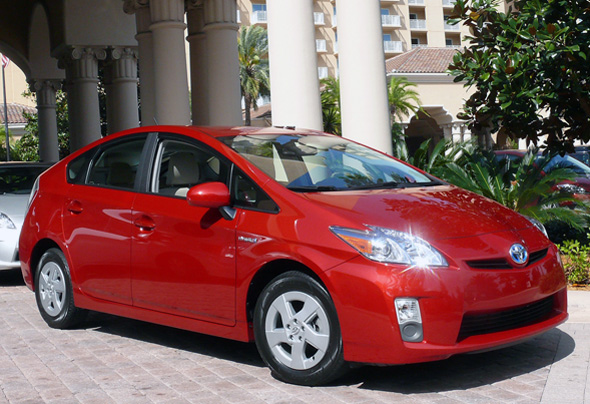 There were three of us, sharing a 42-mile test loop on the highways surrounding Orlando, Fla., in order to evaluate the new 2010 Toyota Prius. We were on rural and suburban roadways, and our speed and routine varied considerably. We drove with a bit of care, hoping to get optimum fuel economy, and when we got back, a Toyota official located the proper button to get the proper meter to read our proper performance.
There were three of us, sharing a 42-mile test loop on the highways surrounding Orlando, Fla., in order to evaluate the new 2010 Toyota Prius. We were on rural and suburban roadways, and our speed and routine varied considerably. We drove with a bit of care, hoping to get optimum fuel economy, and when we got back, a Toyota official located the proper button to get the proper meter to read our proper performance.
We had gotten 59.3 miles per gallon during out test run of the restyled hybrid sedan. That wasn’t good enough to win the media high-mileage contest – somebody on the previous wave had gotten 77 miles per gallon, and we figured he must have paid for a tow – but 60 miles per gallon is sensational in its own right. The Prius EPA figures claim 50 miles per gallon in town. We proved that is definitely attainable.
The new-for-2010 Prius is improved in virtually every characteristic, befitting the third generation of the car that has sold 700,000 units in the U.S., and 1.2 million worldwide, in its campaign on changing the way drivers drive. When you shop for a hybrid, make sure it has a small engine and can attain high gas mileage numbers. The beauty is that the Toyota system could be adapted to any and every model.
The new car is 90 percent all new, and will also make it an easier transition for skeptics who haven’t yet accepted that the electric energy generated by the gas engine in a hybrid is cleaner and more potent than the power from the gas engine. As if to underscore that, Toyota’s Hybrid Synergy Drive system has advanced its battery-pack technique to gain power while losing weight and size, while the interlocked system remains uniquely the same – a concept many journalists and even major auto magazines apparently continue to misconstrue.
The gasoline engine in the Prius, or any Toyota/Lexus hybrid, will NEVER turn a wheel on the vehicle by itself. It only serves to send power through a generator, which generates the electricity to power two electric-drive motors that propel the car. The explanation at the press briefing was slightly confusing, because in EV mode, the Prius is all-electric up to 25 mph and can go that way for about one mile, with the hybrid batter working through the electric motors. In ECO mode, power is combined with input from the gas engine increased and working with – but still through – the generator for smoother throttle and power adjustments in congested traffic. And in Power mode, increased power allows more punch for easier access to freeway entries and added sportiness.
While many apparently think that means the Power mode is gas-engine only – as it is in Ford’s system – it isn’t. I simply asked the Toyota engineers, at the press briefing, and they acknowledged that even when the gas engine is used at its maximum, it still is combined with electric and runs through the generator.
The 1.8-liter gas engine is free of accessory belts, because Toyota designed it to make the power steering electric, and, coupled with improved suspension design, it allows the new car to have a much improved on-center feel compared to the fairly numb feeling of its predecessor.
As for moving the Prius, the system has a much smaller inverter, but as for the power, Motor Generator 1 (MG1) is lighter, smaller and more effective in starting the car and controlling the gas/electric coordination; Motor Generator 2 (MG2) is also smaller and has higher RPM capability; the battery pack itself is the same as in the current car. That, in fact, is the 10 percent of the renovated car that is not all-new.
If you don’t believe we have to switch from driving large-engined, hefty vehicles for everyday use, check the news for the daily crisis reports about General Motors, and how the government has had to make shocking moves to prevent what it feels could be a total collapse of the company – bailout loans or not. We also have to change our mindset, because it’s become trendy for large-vehicle drivers to treat hybrid drivers with scorn, for being tree-huggers, and “environmentalists†– a word gas-hog drivers spit out as if it’s the lowest form of wimpism.
It tells a lot about U.S. society that we bought a steady stream of Prius vehicles until gasoline spiked at $4 per gallon, and then we bought every Prius and Honda Civic hybrid available and created a waiting list. However, when gas prices subsided in recent months, we quit buying the Prius and other small, high-mileage cars. Of course, we quit buying any cars. Thankfully, we didn’t return to buying enormous trucks and SUVs, because there is an excellent chance gasoline prices will rise again as summer approaches.
Some cynic challenged Toyota officials because hybrid sales dropped more than the norm; obviously, because they had increased by a greater margin during the gas hike, they had more to decrease when the prices went back under $2.
In a capsule, the most significant improvements to the new Prius include: three selectable driving modes, EV for low-speed electric operation when fully charged, Eco for normal traffic, and Power for more performance; it has standard 4-wheel disc brakes, traction control, antilock brakes with electronic brake distribution; it has a solar-powered ventilation system that can exchange interior air via the energy from a solar panel’ in the roof; remote pre-air-conditioning ; lane-keep assist to warn if you wander across the lane-dividing line without signalling or turning the steering wheel; intelligent parking assist with an amazing hands-off system that parks itself, just like the big Lexus LS600; dynamic radar cruise control, which can set and maintain a safe interval behind the car ahead; and a precollisin system that warns you if an object is in the way ahead, and will prepare for a panic stop and even apply the brakes if necessary.
These are major upgrades, although it hit me that maybe one of the reasons that Toyota wasn’t ready to divulge the price of the new car is that some of those features are also quite expensive to install. For the first time, the Prius is available with a sunroof, and adding the solar panels means the interior will be ventilated by solar energy without using the air conditioning. Holding the remote button will activate the air-conditioning, which will run off the hybrid batteryfor three minutes, or until the door is opened.
Toyota has done a fantastic job creating the hybrid Prius and placing it high on a pedestal , and it has done an even more fantastic job of marketing to Prius, in its hand-to-hand combat with Honda’s top hybrids. So good has Toyota’s marketing been that many people know the Prius as the only true hybrid available, which helps explain why the Prius accounts for 50 percent of all hybrids sold.
By comparison, many consumers don’t even know the Honda Civic comes in a hybrid version and is extremely competitilve with the Prius for performance and fuel economy. Honda is about to bring out its new Insight, a smaller, sleeker 4-door hybrid sedan, although I’ll have to test one to convince myself it will get the same fuel economy as I’ve been able to attain with the Civic Hybrid.
Toyota has now come out with an entirely new and revised Prius, and while it retains the distinctive angular shape, it is improved from virtually every angle. Its roofline now reaches its peak 4 inches rearward from where the current car hits its highest spot, improving rear seat head and legroom slightly but significantly. The grille is smaller, but the lower airscoop under the bumper is larger and more boldly styled. The side has a slightly altered silhouette, and it comes to a higher, flatter rear deck.
Underside trays improve the aerodynamics and disperse the passing wind with strategically located splitters. It is longer and wider, but by less than an inch in both cases. Careful wind-tunnel testing has delivered a Prius with a sensational 0.25 coefficient of drag.
It seems odd that the Prius has, of all things, a larger gasoline engine, but the 1.8-liter, which has a valve-altering Atkinson Cycle system, has more torque and works less strenuously on the highway.
It might be quicker, it handles better, and for certain it will get better fuel economy, and the Toyota marketing machine is charging full-speed ahead.
{IMG2}
I like the existing Prius, angular shape and all. Honda, which took a different path since being first on the U.S. market with the Insight 2-seat hybrid, makes the Civic Hybrid as a model of the Civic, so it looks the same as other Civics. Whether it’s better to make your hybrid look mainstream, like the Civic, or distinctly difference, like the Prius, is open to debate. But without a doubt, the new Prius is better than the current model.
The last time I drove a Prius for a week’s test in Minnesota, I was able to coax it up to 43 or 44 miles per gallon. I know owners who have gotten better than that, but I was driving it on my normal swing that includes driving in both the Twin Cities and Duluth, as well as the freeway drive between the two cities and back. I got 47.7 miles per gallon with the Civic Hybrid, but the fact that it is comparatively unknown comes under the heading that if a hybrid car is capable of 50 mpg, but nobody knows it exists, does it really happen?
The Prius was introduced in its latest form at Orlando, Fla., home of Disney World. Which was fitting, because Fantasyland seems a great regional attraction for a car that runs on both a gasoline and electric power, with the gas engine rejuvenating the electrical energy while you drive.
The lone drawback to the Prius, and the Toyota Hybrid Synergy Drive in all applications, is in extreme cold, if the car is left outside. Power from the batteries can drain to zero, and the gas engine will start up, but will not move the car. Similarly, if anything happens to the electric system, the car won’t budge and you need a tow.Thw Honda system will keep running on the gas engine even if the eectric system fails. But in either vehicle, the electric power system is pretty much bulletproof.
Living with a garage at home and at work, and avoiding lengthy outside parking when it’s 20 below in Minnesota, can lead to a long and profitable relationship with any Prius. In 2008, 1,734 Priuses were sold in the Minneapolis area, which is 8 percent of the size segment, and makes it second highest in penetration in the Upper Midwest to Madison, which sold enough Priuses to make up 14.2 percent of midsize sales. In Chicago, by comparison, Prius sales were 5.6 percent of the segment.
The third generation Prius is better than ever by comparison. Which is saying something. As Toyota small car manager Ed LaRocque said: “The Prius has become an icon, and has proven that it’s not some kind of science project.Ââ€
Hyundai Genesis Coupe is pure performance bargain
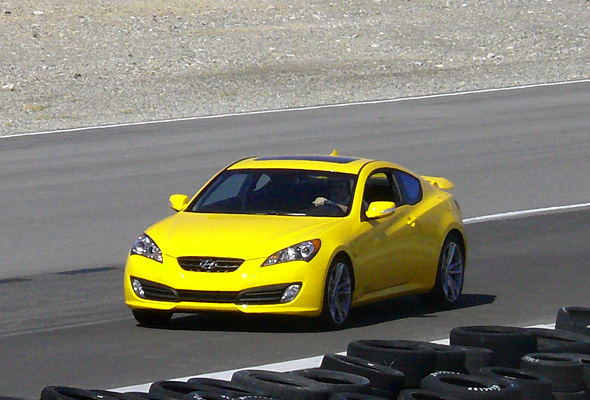 Hyundai struck gold when its new Genesis sedan won the North American Car of the Year award in January, and now the South Korean company is mining another vein, boldly taking on the world’s most fun-to-drive sporty vehicles with the Genesis Coupe.
Hyundai struck gold when its new Genesis sedan won the North American Car of the Year award in January, and now the South Korean company is mining another vein, boldly taking on the world’s most fun-to-drive sporty vehicles with the Genesis Coupe.
The unrelated-except-by-name Genesis Sedan and Coupe are seriously altering Hyundai’s reputation, which has always been for simple and inexpensive vehicles with great warranties. The new wave of Hyundais has taken a decided step up the technology and quality ladders – while retaining the amazing low-price and high-warranty features that have vaulted Hyundai to the upper echelon of all the satisfied-customer ratings.
The new Coupe is not embarking on its journey meekly, but instead is stating flat-out that its targets are sporty coupes that include the Infiniti G37, and the BMW 3-Series coupe – both among my personal favorites, if you choose to buy your sporty coupe with winter-risk rear-wheel drive. As far as that challenge goes, the Genesis Coupe is lighter than the Infiniti G37, and its chassis is 24 percent stiffer in bending rigidity than the M3, BMW’s ultra-stiff performance 3-Series model.
It goes without saying that the Genesis Coupe also will welcome comparisons with Ford Mustang, the Dodge Challenger, the yet-to-be-released Chevrolet Camaro, and the Mitsubishi Eclipse.
The Genesis Coupe has a nicely chiseled nose, flaring up from the grille, and from the side, the front has its own wedgy angle outlined by a firm contour, while a second groove runs from the rear and comes in above the first, complementing the sloping roofline, which kicks back for the rear window opening. The rear is nicely designed too, with an optional spoiler atop the hatch, and a blacked-out lower valence that outlines the dual exhaust tubes. With a low side sill and a thin line of windows, the Coupe is attractive and distinctive from every angle.
Hyundai is preying on the word “Genesis†much more than building a coupe off the sedan. Genesis, insiders say, is code for front-engine/rear-drive performance, which is a departure for the company. Until Genesis, all Hyundais – from the luxury Azera, down through the midsize Sonata to the compact Elantra and the subcompact Accent, with sidetrips through the SUVs such as Veracruz, Santa Fe and Tucson – have been front-wheel drive or front-drive with all-wheel drive variations.
Obviously, in Minnesota, front-wheel drive or all-wheel drive remains a very important asset, and it does seem that the Genesis Sedan might add an AWD model. But there are those who like the performance feel of front-engine/rear-drive, and they insist that because hard acceleration makes a natural transition of power to the rear, and traditional sports cars and German luxury cars have featured rear-drive, it should be the norm. It is those traditional performance drivers Hyundai is aiming at with the Genesis siblings, more than Minnesota winter drivers.
The Genesis Sedan is large and luxurious, measuring 195.9 inches in length, and 4,000 pounds, while the Genesis Coupe is low and slinky at 182.3 inches in length and 3,300 pounds. The Genesis sedan has a potent and extremely high-tech 4.6-liter V8 and a well-refined 3.8 V6 for power; the Genesis Coupe instead uses that revised 3.8 V6 as its optional upgrade, to go along with its basic 2.0-liter 4-cylinder.
Before scoffing at the smaller engine, however, know that it has dual overhead camshafts with dual variable valve-timing on both intake and exhaust valves, which are whipped to a proper frenzy of action by an intercooled Mitsubishi turbocharger, so it makes 210 horsepower at 6,000 RPMs, and 223 foot-pounds of torque at only 2,000 RPMs.
The 3.8-liter V6 also has dual overhead cams and variable valve timing and delivers a potent 306 horsepower at 6,300 RPMs, and 266 foot-pounds of torque at 4,700 RPMs. Enough to vault the Coupe from 0-60 in down around 5 seconds, but the 4 won’t be far behind, as the turbo spools up and zips the Coupe right along. The V6 model has an electronic cutoff at 149 miles per hour, and the 2.0 Turbo at 137 mph.
Another surprise is that both engines are tuned to run on regular gas – an enormous benefit, when you see some gas stations charging 20 cents or more higher for premium.
Maybe the power, performance, tightness and crisp handling were all pleasant surprises, compared to Hyundais past, but the biggest and most-pleasant surprise to me was that the Genesis Coupe with the 4-cylinder and a 6-speed manual transmission starts at only $23,750. That’s a good price for a decent midsize sedan, and an absolute steal for a sleek, attractive sports coupe.
The V6-powered upgrade can be had for $25,000. Both versions come in basic form, with the 2.0 Turbo moving up to a Premium level, and then a top Track level. The 3.8 moves up to a Grand Touring middle-range model, then a top level 3.8 Track. with option-gusts up to $35,000. The Track version of both get firmer suspension settings, the 6-speed sticks, and enlarged Brembo brakes.
Those prices are bargains by any comparaison, especially when you examine features, and hold that 10-year/100,000 mile warranty in reserve.
The introduction of the Coupe was held in Las Vegas, and we got to go out to Spring Mountain Motorsports Park, a road-racing track out in the desert, to put the Coupes through all paces. Included were repeated laps around half of the road-course, plus a fairly tight and fast autocross. There also was a separate circular area set apart for “drifting,†which is the recent sport that has found popularity with younger enthusiasts. In drifting, you spin the rear tires until the smoke, then you zoom around a circle out of shaps but without losing control while your rear tires send off plumes of blue smoke.
I apologize here, but I’ve bought too many tires to engage in the drifting, even though Bridgestone officials were standing by, smiling enthusiastically as thousands of miles of treadlife went up in smoke. Watching it was so unappealing that it made me slightly ill. There are a lot of ways to have fun in a car without such blatant waste.
{IMG2}
Driving to the track in the turbo-4 and driving back to the Red Rock Resort in the V6 model proved both were impressive, although my partner was more bothered than I at the vibration of the 4. I don’t mind a little buzziness from my 4s. But he had a point, and Hyundai engineers acknowledged that they considered it but decided against installing counter-balance shafts because the engine already has a dual-mass flywheel, plus the compromise in cost and weight.
At the road-racing course, both versions of the Coupe were fun to drive, and to push to their limits. The V6 pulled hard in every gear, either with 6-speed stick, or the slick Z-F (say “Zed-FÂâ€) 6-speed automatic and the easily shifted manual paddles reachable from the steering wheel. The turbo 4 ran out of steam on a couple of the turns, where I found I was either out of torque or out of revs. That was more due to the spacing of the gears, perhaps, because I liked the idea that the gears were spaced for optimum highway fuel economy, rather than drag-racing-type close ratios.
On the multi-turn and zig-zagging autocross course I was most impressed, because it was there that I worked to get my best time down to the 23-second bracket with the V6 stick. When I switched to the V6 automatic, I was surprised that I matched my best stick-shift time, and I found that if you paddle it to first, it upshifted by itself once at the first turn when you got to red-line – and idiot-proof assurance against over-revving – and then second gear was perfect for the rest of the run.
I was even more impressed when I took the 4-cylinder stick out on the same track, and found that I was able to again match the V6’s best under-24-second times with the 4. That’s real-world performance, and proves that you could save a lot of money, particularly on fuel economy, where the 4 can reach 30 miles per gallon.
Handling is precise and stable, with a dual-link MacPherson strut suspension up front and a five-link independent rear suspension arrangement, complete with standard electronic stability control and traction control, and available Torsen limited slip governing the rear axle.
Inside, the driving position is very good, with firmly bolstered seats and all the controls laid out with ergonomic efficiency.
There can be no denying Hyundai’s rapid emergence within the industry. Hyundai only started building cars 22 years ago, licensed to recreate the Mitsubishi subcompact as the Excel. It sold so well that Mitsubishi bought some back to sell as its own entry-level Precis. At any rate, Hyundai started building its own engines, which were pretty conservative for a few years.
But consider that Honda, Toyota and Nissan, for example, have been making cars for over 50 years, and their first cars were nothing to write out a check about. They improved dramatically through the years, which made more vehicles and more challengers out there for Hyundai to strive to meet.
In 2001, market research showed that 12 percent of all auto buyers said they would consider a Hyundai; now that figure is 26 percent. Honda and Toyota stand at over 50 percent, though, and that’s where Hyundai wants to get.
All auto makers are struggling against the faltering economy right now, although there have been months where Hyundai was one of very few to show an improvement over the same month a year ago. Overall, sales are down for every company, but Hyundai’s overall loss of sales in the past year has been small enough that it actually gained market share. Its market share is only at 4.1 percent, but that represents an increase of 70 percent.
And that’s without a full year of the Genesis Sedan, and before anybody has driven away in a Genesis Coupe.


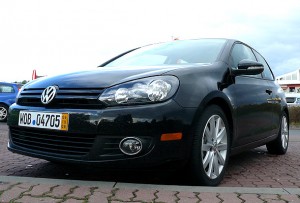
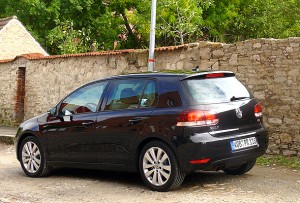
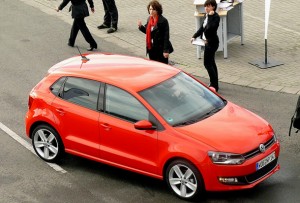
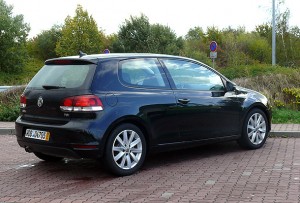
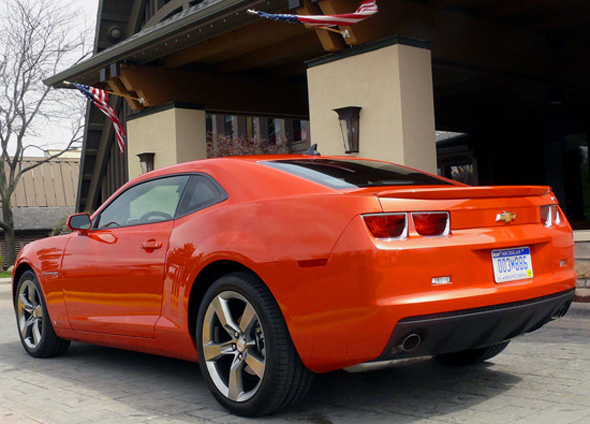
 John Gilbert is a lifetime Minnesotan and career journalist, specializing in cars and sports during and since spending 30 years at the Minneapolis Tribune, now the Star Tribune. More recently, he has continued translating the high-tech world of autos and sharing his passionate insights as a freelance writer/photographer/broadcaster. A member of the prestigious North American Car and Truck of the Year jury since 1993. John can be heard Monday-Friday from 9-11am on 610 KDAL(www.kdal610.com) on the "John Gilbert Show," and writes a column in the Duluth Reader.
John Gilbert is a lifetime Minnesotan and career journalist, specializing in cars and sports during and since spending 30 years at the Minneapolis Tribune, now the Star Tribune. More recently, he has continued translating the high-tech world of autos and sharing his passionate insights as a freelance writer/photographer/broadcaster. A member of the prestigious North American Car and Truck of the Year jury since 1993. John can be heard Monday-Friday from 9-11am on 610 KDAL(www.kdal610.com) on the "John Gilbert Show," and writes a column in the Duluth Reader.